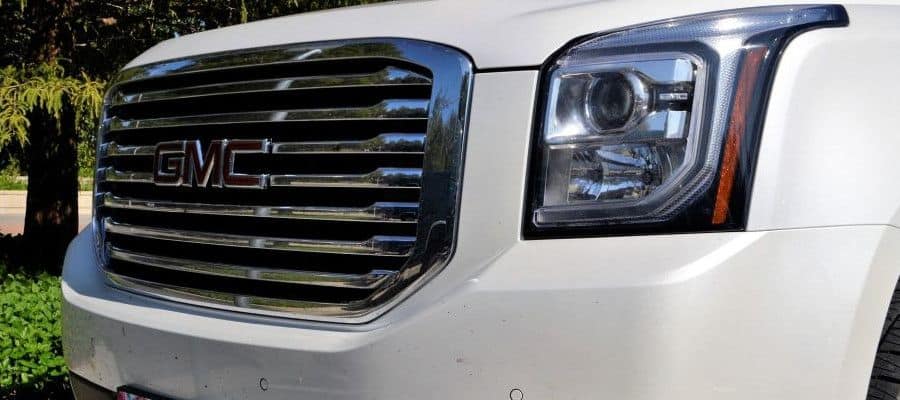The RFAR category at Sixt includes vehicles that offer generous interior space, all-wheel drive, and features suited for long-distance travel. All models in this class also come standard with air conditioning and automatic transmission. In this article, we take a closer look at two vehicles that are commonly rented in this category through Sixt.
Sixt RFAR
Designed for comfort and space, full-size SUVs in the RFAR category are ideal for families, long road trips and travelers who need extra room.
More About This Class
GMC Acadia
The current model year of the GMC Acadia is offered exclusively with a 2.5-liter turbocharged four-cylinder engine. This boosted gasoline unit delivers 328 horsepower and a maximum torque output of 442 Nm (326 lb-ft). Power is routed through an 8-speed automatic transmission, available with either front- or all-wheel drive. Overall, power delivery is confident, though the transmission doesn’t always find the optimal gear—particularly during sudden acceleration, where shifts can feel slightly delayed. Towing capacity is rated at up to 5,000 pounds, placing the Acadia at the upper end of its segment in this regard.
Despite its nearly five-meter length and curb weight exceeding two metric tons, the Acadia remains manageable in everyday driving. The suspension is tuned for comfort and absorbs road imperfections well, especially in urban environments and on uneven secondary roads. However, at highway speeds, the body exhibits some noticeable vertical movement over long undulations. The steering is accurate enough for typical use, though it lacks road feel and doesn’t provide much feedback. Cornering reveals a fair amount of body roll, making it clear that the Acadia was not engineered with sporty handling in mind. That said, overall stability is good, and the driving experience is predictable and clearly optimized for long-distance comfort.
The interior layout is practical, with generous space in the first and second rows. The seats are cushioned softly, though lateral support is limited. The third row is more suitable for children or short trips. At the center of the dashboard sits a 15-inch touchscreen infotainment system running Google-based software, which is logically structured and operates smoothly. A digital instrument cluster complements the main display and provides essential driving data. Materials are of solid midrange quality, with soft-touch plastics, leather upholstery (depending on trim), and well-assembled switchgear that create a refined atmosphere without straying into luxury territory.
GMC offers a wide range of optional driver-assistance and comfort features. Chief among them is the Super Cruise system, which enables hands-free highway driving under certain conditions, though its availability is currently limited to North America. Other options include a 12-speaker Bose premium audio system, a multi-color head-up display, and a suite of cameras providing full 360-degree visibility. Standard safety features include automatic emergency braking, lane-keeping assistance, and adaptive cruise control.
In terms of cargo capacity, the Acadia delivers practical usability: about 23 cubic feet (651 liters) of space with the third row in place, expandable to over 97 cubic feet (2,760 liters) when both rear rows are folded flat. The second and third-row seats fold down easily—electrically in the case of the third row—creating a nearly flat load floor. The load lip is slightly high, which may require extra effort when lifting heavy items. Numerous storage compartments and USB-C ports in all three rows reinforce the Acadia’s utility-focused interior design. Form follows function here, with a clear emphasis on practicality over aesthetic flair.
Mazda CX90
Mazda offers the CX-90 in the U.S. market with two distinct powertrain options. The primary setup features a 3.3-liter inline-six engine paired with a mild-hybrid system. In its standard configuration, it produces 280 horsepower and 332 lb-ft of torque. The more powerful Turbo S version increases output to 340 horsepower and 369 lb-ft of torque. Both variants come standard with an eight-speed automatic transmission and all-wheel drive.
Alternatively, the CX-90 is also available as a plug-in hybrid. This version combines a 2.5-liter four-cylinder gasoline engine with an electric motor and a 17.8-kWh battery. The total system output is 323 horsepower and 369 lb-ft of torque. The PHEV can travel up to 26 miles on electric power alone, making it particularly well-suited for shorter commutes and city driving. In everyday use, the inline-six delivers a more refined and confident driving experience, while the plug-in hybrid stands out for its quiet operation and improved efficiency on short trips.
Mazda is known for building driver-focused vehicles, and the CX-90 is no exception. Despite its size, the SUV offers responsive handling and impressively precise steering for this segment. The suspension is tuned on the firm side, which promotes a sportier driving character but can result in a somewhat stiff ride on rough or uneven roads. Compared with rivals like the Kia Telluride, which prioritizes ride comfort, the CX-90 delivers a noticeably more dynamic experience behind the wheel.
Inside, the CX-90 reflects Mazda’s clear ambition to move further into the premium space. High-quality materials, such as Nappa leather and well-finished trim surfaces, create a refined and upscale cabin environment. The infotainment system is accessed via a 12.3-inch display, which is sharp and responsive but requires some acclimation due to its layered menu structure. The first and second rows offer generous space and comfort, while the third row, as with many three-row SUVs, is best suited for children or shorter journeys.
Mazda equips the CX-90 with a comprehensive suite of modern driver assistance systems. Standard or available features include adaptive cruise control, lane-keeping assist, and a 360-degree surround-view camera. One standout option is the head-up display, which projects essential driving information directly into the driver’s line of sight. Compared to competitors like the Toyota Grand Highlander, which offers a similar tech package, the CX-90 benefits from a more seamless and intuitive user experience.
With the third-row seats in place, the CX-90 offers approximately 15.9 cubic feet of cargo space (around 450 liters). Folding down the rear rows expands storage capacity to up to 77.7 cubic feet (about 2,200 liters), providing ample room for larger hauls. An electric tailgate simplifies access to the cargo area, while numerous interior storage compartments add everyday practicality.

